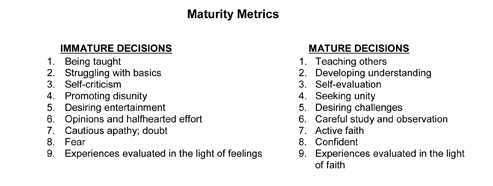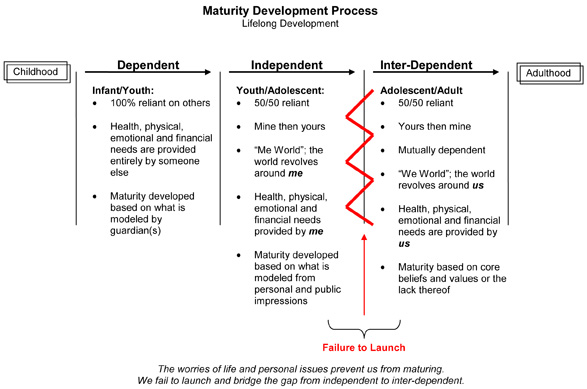
Cultivating a Mature Workforce

Your workforce is one of your project’s greatest assets. From the top down, the maturity of this asset has a dramatic impact on your safety culture and ultimately your bottom line.
In this article I identify personal maturity metrics. By using the metrics, maturity is now identifiable. The idea is that your safety culture becomes stronger based on each individual’s ability to demonstrate mature behaviors. We can now recognize, demonstrate and teach these mature behaviors at all levels of management. In doing so, we are fostering maturity by empowering personal responsibility.
The reverse holds true as well; your safety culture weakens based on each individual’s demonstration of immature behaviors. When we see immaturity at work – undermining our core values – we can learn to take mature, proactive steps to corrective actions. In doing so, we deal directly with the lack of personal responsibility when it comes to maturity.
It’s important to note that, when referring to behavior, we look outside of the safety industry. We turn to the science and study of human behavior that clearly illustrates behavior is a byproduct of thoughts and emotions. Accepting this as fact, we can now identify mature thoughts and emotions that lead to mature behaviors. Additionally, we can now identify immature thoughts and emotions that lead to immature behaviors, which in turn undermine safe work practices during hazardous conditions.
Maturity Metrics
The Maturity Metrics™ identifies a framework to better understand maturity and immaturity (see Figure 1). This framework becomes the reference guide to dealing directly with immaturity. The framework can also be used to identify, teach and demonstrate mature behaviors.
Figure 1

Being Taught (Immature) vs. Teaching Others (Mature)
When the knowledge transfer stops with you, or when you fail to pass on or receive what’s been transferred to you, your immature thoughts and emotions are holding you back from optimal job performance. More importantly, they could be undermining your safety culture.
There are many reasons why someone would not actively teach others. The list is long and discerning, including everything from low self-esteem to apathy. Workforce immaturity reveals itself every day in crew meetings and work groups as people knowingly and willingly withhold information, insights and personal experience.
A mature workforce leads to a mature safety culture when there is evidence of knowledge transfer from one employee to the next, regardless of titles, roles or responsibilities. Each employee in the office and in the field must promote the mature behavior of teaching others – the concentrated, disciplined effort to share and receive information.
All levels of your workforce, from senior management to laborers, must learn to break through the old paradigm of command and control whereby only a few at the top know what’s going on and everyone else just does as they are told. This is an example of an immature safety culture.
Struggling with Basics (Immature) vs. Developing Understanding (Mature)
You are engaging in immature behavior when the negativity and struggle within you continue to take up valuable time and energy, or when you continue to wrestle over a difficult person, place or thing. The key word in this statement is “continue.” It is not immature to struggle as we all struggle. However, it is immature to continue to struggle rather than learn to rise above and develop understanding.
Maturity is your ability to recognize the struggle. The subject matter or source of your struggle – that person, place or thing – is a secondary interest. Immaturity has you focused on the person, place or thing only to keep you distracted in thoughts and emotions. Liars lie, cheaters cheat and immature people act in an immature manner. Instead of walking around for days on end struggling with why people do these things, we should no longer struggle but seek to understand why. This is maturity in action.
A mature workforce learns to recognize the struggles and makes decisions accordingly. A mature employee recognizes the skill gaps, communication gaps and personality gaps, and seeks to understand the differences. The immature culture continues to focus on or does little to address the gaps and internally propagates water-cooler gossip, disruptive emails and other immature behavior that slowly undermines the core values of the project.
Opinions and Halfhearted Effort (Immature) vs. Careful Study and Observation (Mature)
Maturity involves learning from oneself. By making mature self-observations, correction and wiser decision-making are learned over time. This maturity principle reveals itself most often in behavior-based safety programs that allocate time and effort to study and observe behaviors.
A mature employee learns to study and observe two domains, personal and public. Said another way, a mature individual learns to study and observe their thoughts and emotions as well as what’s happening in their surroundings. When the individual employee holds oneself accountable to maturity, the culture in turn learns to study and observe what is going on around the project.
An immature employee takes no interest in the study of self or surroundings. Instead, the immature employee would rather offer shortsighted opinions and halfhearted effort, only to directly and indirectly undermine the core values of safely performing work.
The Foundation of Maturity
Today’s demands of creating a safe work culture require personal maturity from the top down. Although maturity is personal, it reveals itself in public interactions. It is personal responsibility that becomes the foundation of the maturity process. The maturity process is not a guarantee nor does it have a direct correlation to age (see Figure 2).
Figure 2

In the never-ending quest to improve human performance, maturity has become a growing interest among many professionals. If you have a personal story of maturity and how it has affected your safety culture, please send your story to parrish@parrishtaylor.com.
About the Author: Parrish Taylor is the author and instructor of the soft-skills instructional program Maturity Matters™. He has successfully implemented workforce development strategies within the electric utility sector for clients including Entergy, Cleco and Oklahoma Gas & Electric. Learn more about the Mature Safety Track at the iP Safety Conference & Expo in Louisville, Ky., October 3-5 or visit www.parrishtaylor.com. If you have questions or personal insights about the topic of maturity, contact Parrish at 866-487-2815 or parrish@parrishtaylor.com.

